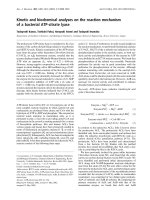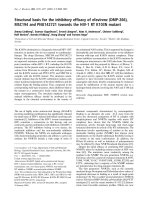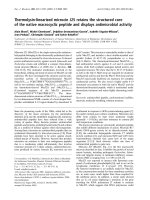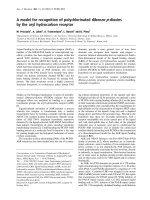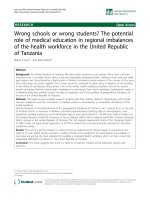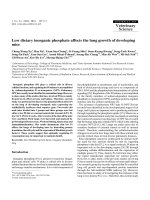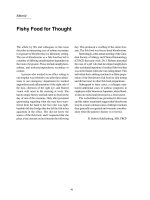Báo cáo y học: "Fluvoxamine monotherapy for psychotic depression: the potential role of sigma-1 receptors" pps
Bạn đang xem bản rút gọn của tài liệu. Xem và tải ngay bản đầy đủ của tài liệu tại đây (155 KB, 3 trang )
BioMed Central
Page 1 of 3
(page number not for citation purposes)
Annals of General Psychiatry
Open Access
Case report
Fluvoxamine monotherapy for psychotic depression: the potential
role of sigma-1 receptors
Tsutomu Furuse*
1
and Kenji Hashimoto
2
Address:
1
Department of Psychiatry, Asahikawa Red Cross Hospital, Asahikawa, Japan and
2
Division of Clinical Neuroscience, Chiba University
Center for Forensic Mental Health, Chiba, Japan
Email: Tsutomu Furuse* - ; Kenji Hashimoto -
* Corresponding author
Abstract
Background: Psychotic depression is a clinical subtype of major depressive disorder. A number
of clinical studies have demonstrated the efficacy of the combination of an antidepressant (for
example, a tricyclic antidepressant or selective serotonin reuptake inhibitor (SSRI)) and an atypical
antipsychotic or electroconvulsive therapy in treating psychotic depression. In some cases, the
clinician or patient may prefer to avoid antipsychotic drugs altogether because of the risk of
extrapyramidal side effects (EPS) in patients with psychotic depression treated with these drugs.
Methods: We report five cases where fluvoxamine monotherapy was effective in the patients with
psychotic depression.
Results: The scores on the Hamilton Depression (HAM-D) scale and the Brief Psychiatric Rating
Scale (BPRS) in the five patients with psychotic depression were reduced after fluvoxamine
monotherapy.
Conclusion: Doctors should consider fluvoxamine monotherapy as an alternative approach in
treating psychotic depression because it avoids the risk of EPS from antipsychotic drugs.
Background
Psychotic depression is a clinical subtype of major depres-
sive disorder and is characterized by psychosis accompa-
nied by relatively severe depressive symptoms that include
psychomotor impairment, morbid cognition, suicidal
ideation and neuropsychological impairment. Unfortu-
nately, psychotic depression frequently proves difficult to
treat. A number of clinical studies have demonstrated the
efficacy of the combination of an antidepressant (for
example, a tricyclic antidepressant or selective serotonin
reuptake inhibitor (SSRI)) and an atypical antipsychotic
or electroconvulsive therapy (ECT) in treating psychotic
depression. In some cases, the clinician or patient may
prefer to avoid antipsychotic drugs altogether because of
the risk of extrapyramidal side effects (EPS) in patients
with psychotic depression treated with these drugs [1].
Interestingly, monotherapy using the SSRI fluvoxamine
was effective against both the psychotic and depressive
symptoms of this disorder [2,3], whereas paroxetine had
a lesser effect [4]. The reason underlying the difference in
efficacy for these two SSRIs is currently unknown. Several
pieces of evidence suggest that the endoplasmic reticulum
protein sigma-1 receptors play a role in the pathophysiol-
ogy of depression and in the active mechanisms of antide-
pressants [5,6]. Unlike paroxetine, with an inhibition
Published: 21 December 2009
Annals of General Psychiatry 2009, 8:26 doi:10.1186/1744-859X-8-26
Received: 10 November 2009
Accepted: 21 December 2009
This article is available from: />© 2009 Furuse and Hashimoto; licensee BioMed Central Ltd.
This is an Open Access article distributed under the terms of the Creative Commons Attribution License ( />),
which permits unrestricted use, distribution, and reproduction in any medium, provided the original work is properly cited.
Annals of General Psychiatry 2009, 8:26 />Page 2 of 3
(page number not for citation purposes)
constant (Ki) of 1893 nM, fluvoxamine is a potent sigma-
1 receptor agonist with a Ki of 36 nM [5]. A positron emis-
sion tomography study demonstrated that fluvoxamine
(50 to 200 mg), but not paroxetine (20 mg), binds to
sigma-1 receptors in the intact human brain at therapeutic
doses [5], suggesting that sigma-1 receptors are involved
in the active mechanisms of fluvoxamine [5]. Based on all
these findings, a hypothesis has been proposed that the
sigma-1 receptors may be implicated in the efficacy of flu-
voxamine for psychotic depression [7-9]. Here, we report
five cases in which fluvoxamine monotherapy was effec-
tive in Japanese patients with psychotic depression.
Case reports
Table 1 shows the characteristics of five patients with psy-
chotic major depression diagnosed by Diagnostic and Sta-
tistical Manual of Mental Disorders, 4th Edition (DSM-IV)
criteria. Case 1 was admitted to the hospital due to sleep
disturbance and delusion. The Hamilton Depression
(HAM-D) scale and the Brief Psychiatric Rating Scale
(BPRS) scores were 34 and 66, respectively. Fluvoxamine
(50 mg twice a day) and flunitrazepam (2 mg) were initi-
ated, and the next day fluvoxamine was increased to 100
mg since there were no gastrointestinal side effects. The
patient's condition was better 7 days after beginning treat-
ment with fluvoxamine, but she still showed a tendency to
want to go to bed. Therefore, fluvoxamine was increased
to 150 mg. By 2 weeks later, her activity levels had recov-
ered. Her HAM-D and BPRS scores had dramatically
decreased (Table 1), and she was discharged home 3
weeks after beginning treatment with fluvoxamine.
Case 2 had delusions of being observed, and was admitted
to the emergency centre of the hospital after eating ciga-
rettes as a suicide attempt. The HAM-D and BPRS scores
were 42 and 77, respectively. Fluvoxamine (50 mg twice a
day) and flunitrazepam (2 mg) were initiated, and the
next day increased to 100 mg. Fluvoxamine was further
increased to 150 mg because she still had delusions 2
weeks after beginning treatment. Her HAM-D and BPRS
scores decreased (Table 1), and she was discharged to her
home 6 weeks after beginning treatment with fluvoxam-
ine.
Case 3 requested an operation on a cataract, but was
rejected because of the progression of cornea thinning. He
was admitted to the emergency centre of the hospital due
to paranoia and delusions. The HAM-D and BPRS scores
were 45 and 73, respectively. Fluvoxamine (50 mg twice a
day), flunitrazepam (2 mg), and etizolam (0.5 mg) were
initiated, and the next day, fluvoxamine was increased to
100 mg. His HAM-D and BPRS scores dramatically
decreased (Table 1), and he was discharged home 17 days
after beginning treatment with fluvoxamine.
Case 4 had experienced paranoid symptoms for a week.
The HAM-D and BPRS scores were 35 and 69, respectively.
Fluvoxamine (50 mg twice a day) and flunitrazepam (2
mg) were initiated, and the next day, fluvoxamine was
increased to 100 mg. She was better 2 weeks after the
beginning of treatment with fluvoxamine. Her HAM-D
and BPRS scores dramatically decreased (Table 1), and she
was discharged home 3 weeks after beginning treatment
with fluvoxamine.
Case 5 had paranoia and delusion. The HAM-D and BPRS
scores were 45 and 80, respectively. Fluvoxamine (50 mg
twice a day) and flunitrazepam (2 mg) were initiated; flu-
voxamine was increased to 100 mg the next day, and to
150 mg 7 days later. By 3 weeks later, her paranoia and
delusion had disappeared. Her HAM-D and BPRS scores
had decreased (Table 1) and she was discharged home 4
weeks after the beginning of treatment with fluvoxamine.
Discussion
Here we report that fluvoxamine was effective in five
patients with psychotic depression. However, further
studies using large numbers of patients are needed before
it can be concluded that fluvoxamine monotherapy is
effective in patients with psychotic depression. It seems
that serotonin reuptake inhibition as well as sigma-1
receptor agonism may be involved in the active mecha-
nism of fluvoxamine, since paroxetine had a lesser effect
in psychotic depression [4]. Nonetheless, this study did
not clarify whether sigma-1 receptors are involved in the
active mechanism of fluvoxamine. To confirm the role of
sigma-1 receptor agonism in the treatment of psychotic
Table 1: Characteristics and depression rating scores of patients with psychotic depression who responded to fluvoxamine
monotherapy
Pretreatment
score
Post-treatment score
Patient Gender (F/M) Age, years Age at onset, years Duration of illness HAM-D BPRS HAM-D BPRS
Case 1 F 72 72 6 weeks 34 66 7 (3 weeks) 22 (3 weeks)
Case 2 F 54 54 10 weeks 42 77 9 (6 weeks) 32 (6 weeks)
Case 3 M 67 67 6 weeks 45 73 5 (17 days) 26 (17 days)
Case 4 F 60 60 7 weeks 35 69 6 (3 weeks) 22 (3 weeks)
Case 5 F 62 62 8 weeks 45 80 5 (4 weeks) 22 (4 weeks)
BPRS = Brief Psychotic Rating Scale; HAM-D = Hamilton Depression Rating Scale.
Publish with Bio Med Central and every
scientist can read your work free of charge
"BioMed Central will be the most significant development for
disseminating the results of biomedical research in our lifetime."
Sir Paul Nurse, Cancer Research UK
Your research papers will be:
available free of charge to the entire biomedical community
peer reviewed and published immediately upon acceptance
cited in PubMed and archived on PubMed Central
yours — you keep the copyright
Submit your manuscript here:
/>BioMedcentral
Annals of General Psychiatry 2009, 8:26 />Page 3 of 3
(page number not for citation purposes)
depression, a randomized double-blind study of fluvox-
amine (a sigma-1 receptor agonist) and sertraline (a
sigma-1 receptor antagonist)[5,6] in patients with psy-
chotic depression might be helpful.
Conclusions
These cases suggest that fluvoxamine could be an alterna-
tive approach in treating psychotic depression because of
the risk of EPS by antipsychotic drugs. More detailed dou-
ble-blind studies should be performed to clarify the role
of sigma-1 receptors in the efficacy of fluvoxamine for psy-
chotic depression.
Consent
Written informed consents were obtained from the all
patients in this case report.
Competing interests
The authors declare that they have no competing interests.
Authors' contributions
TF contributed to the clinical and rating evaluations dur-
ing the follow-up periods. KH conceived of the study and
participated in its study and coordination. Both authors
read and approved the final manuscript.
References
1. Hamoda H, Osser DN: The psychopharmacology algorithm
project at the Harvard South Shore Program: an update on
psychotic depression. Harv Rev Psychiatry 2008, 16:235-247.
2. Gatti F, Bellini L, Gasperini M, Perez J, Zanardi R, Smeraldi E: Fluvox-
amine alone in the treatment of delusional depression. Am J
Psychiatry 1996, 153:414-416.
3. Zanardi R, Franchini L, Serretti A, Perez J, Smeraldi E: Venlafaxine
versus fluvoxamine in the treatment of delusional depres-
sion: a pilot double-blind controlled study. J Clin Psychiatry 2000,
61:26-29.
4. Zanardi R, Franchini L, Gasperini M, Smeraldi E, Perez J: Long-term
treatment of psychotic (delusional) depression with fluvox-
amine: an open pilot study. Int Clin Psychopharmacol 1997,
12:195-197.
5. Hashimoto K: Sigma-1 receptors and selective serotonin
reuptake inhibitors: clinical implications of their relation-
ship. Cent Nerv Syst Agents Med Chem 2009, 9:197-204 [http://
www.benthamdirect.org/pages/content.php?CNSAMC/2009/
00000009/00000003/0006T.SGM].
6. Hayashi T, Stahl SM: The sigma-1 receptor and its role in the
treatment of mood disorders. Drugs Future 2009, 34:137-146.
7. Stahl SM: Antidepressant treatment of psychotic major
depression: potential role of the sigma receptor. CNS Spectr
2005, 10:319-323.
8. Hayashi T, Su TP: Understanding the role of sigma-1 receptors
in psychotic depression. Psychiatric Times 2005, 22:54-63
[http:w.searchmedica.cosource.html?rurl=http%3A%2F%2Fwww.psy
chiatric
times.com%2Fdisplay%2Farticle%2F10168%2F52596%3FpageNumb%
3D11&q=sigma+receptor&c=ps&ss=psychTimesLink&p=Con
vera&fr=true&ds=0&srid=1].
9. Ishikawa M, Hashimoto K: The role of sigma-1 receptors in the
pathophysiology of neuropsychiatric diseases. J Receptor Ligand
Channel Res 2010, 3:25-36 [ />sigma-1-receptors-in-the-pathophysiology-of-neuropsychiatr-peer-
reviewed-article-JRLCR].


